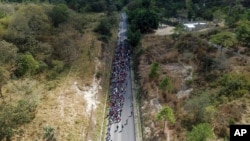The White House’s strategy to curb Central American migration to the United States focuses on job creation, economic investment and support for human rights. Biden administration officials say results are showing, but analysts warn against unrealistic expectations.
A sharp increase in migrants crossing the U.S.-Mexico border has created a political crisis at the start of President Joe Biden’s term in office. He asked Vice President Kamala Harris to spearhead a “root cause” strategy that relies heavily on leveraging U.S. investment to improve living conditions in three Central American countries known as the Northern Triangle: Honduras, El Salvador and Guatemala.
Immigration experts say it will take decades to reduce irregular migration through investment.
“I think this administration knows [that]” said Ariel G. Ruiz Soto, senior policy analyst at the Migration Policy Institute.
“The problem is in the public domain,” he said, explaining that the public expects to see real-time results in a year or two, “but that’s not the case at all economically, even if we have the capacity to invest so.”
Ruiz Soto said the success of this strategy depends on more than just what the White House is doing. It requires governments across the region to commit to significant improvements.
“For example, if Microsoft wanted to build a center in Guatemala, not only would they need to provide funding to build the building, hire workers, and provide training, but they would also need the corresponding funding from the Guatemalan government to build roads, have power infrastructure, and have broadband internet,” he said .
Ruiz Soto said this is not something that can be accomplished in a few years.
not new
This strategy is not new. Under former Presidents Barack Obama and Donald Trump, the United States developed a strategy for engagement in Central America with a focus similar to the five pillars of the Biden administration’s strategy.
“The difference is that their priorities are different, but investing in Central America to reduce irregular migration is not new,” Ruiz Soto said.
In March, the White House released an updated fact sheet showing $5.2 billion in financial commitments from private organizations. The investment is expected to create economic opportunities for Guatemala, El Salvador and Honduras, the White House said.
“I think perhaps the Biden administration’s best achievement is that investment in Central America has become more localized. It has become more targeted and it has become more realistic. But it has not become less political because everyone Hopefully the results will be immediate, but that’s not going to happen,” Ruiz Soto said.
Symptoms of a larger problem
Administration officials believe the situation at the border is a symptom of a larger problem. Many immigrants are forced to come to the United States in search of better economic prospects or to escape violence.
Biden officials say fewer people will be willing to risk the dangerous journey north if economic, security and political challenges in Honduras, El Salvador and Guatemala are resolved.
“Immigration needs to be understood in context – there are increasing numbers of immigrants around the world, including from countries that have only recently become so-called countries of origin,” a spokesperson for the National Security Council told VOA via email. They talk about context , a method often used by U.S. authorities to share information with journalists without revealing their identities.
A spokesperson for the National Security Council wrote that through the government’s Root Cause Programme, more than 250,000 jobs have been created in the region and 3 million young people are supported through education and vocational training.
“As a result of these investments in the region, we are already seeing double-digit growth [percentage] Fewer Central Americans are planning to immigrate,” a National Security Council spokesman said.
Boundary digital fluctuations
Border apprehensions were the highest since 2000 in December, but fell by half over the following three months, according to an April analysis by the rights group Washington Office on Latin America (WOLA).
Some Republicans criticized Harris’ Central America plan, saying it was ineffective or focused too much on foreign aid rather than border security. They said Harris was too focused on long-term solutions rather than the immediate flow of migrants at the border.
work together
In an email to VOA, a spokesperson for the National Security Council drew attention to the Los Angeles Declaration on Immigration and Protection, which brings together more than 20 countries in the Western Hemisphere to strengthen border enforcement, expand legal access, and expand immigration in the region. Cooperate to stop irregular migration. Take new steps to address root causes.
“We have begun laying the foundation for a more competitive regional economy that will spur investment and create better jobs across the Americas,” the spokesperson said.
Ruiz Soto said continuity is key.
“The problem, or at least the way it’s implemented, is that there are differences in how successive U.S. presidents engage in the region,” he said.
He added that efforts alone to improve conditions in these countries would not be enough, even with U.S. funding.
Ruiz Soto said that as the United States seeks strategies to respond to the growing number of migrants fleeing poverty, violence and other challenges in Central America, Northern Triangle governments must commit to governance based on accountability, transparency and development.
“Fundamentally, Guatemala, Honduras and El Salvador have to invest more than the United States to improve their existing conditions. One is money, but also political assistance and the political will to change institutions,” he said.
Follow us on Google news ,Twitter , and Join Whatsapp Group of thelocalreport.in
